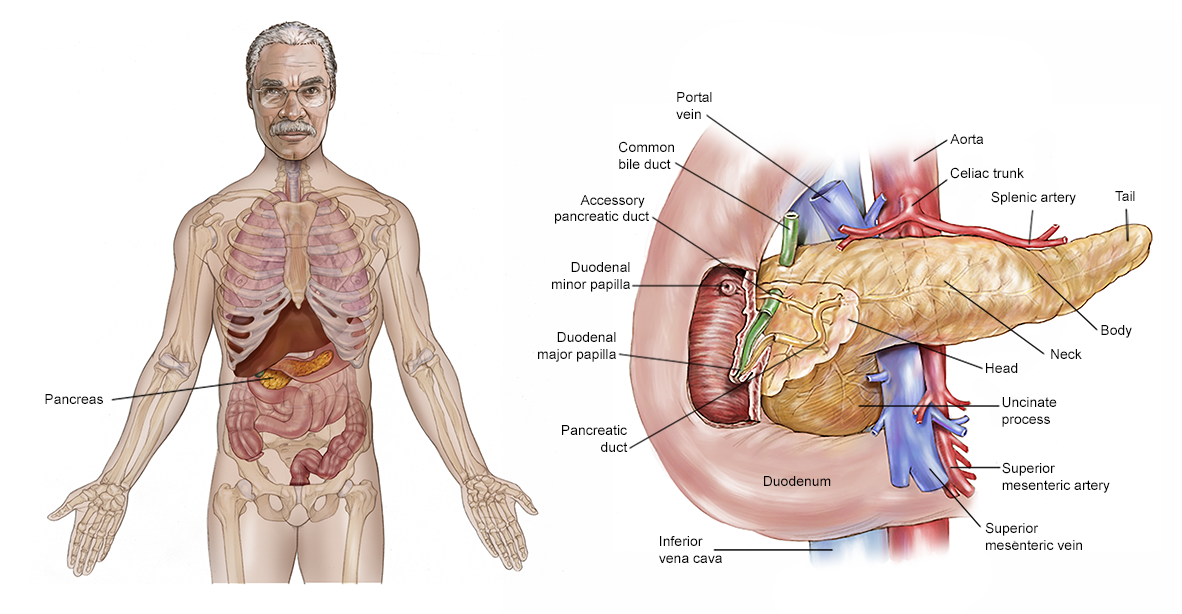Approved by the Cancer.Net Editorial Board, 09/2023
About pancreatic cancer
Pancreatic cancer is a disease in which healthy cells in the pancreas stop working correctly and grow out of control. These cancerous cells can build up and form a mass called a tumor. A cancerous tumor is malignant, meaning it can grow and spread to other parts of the body. As it grows, a pancreatic tumor can affect the function of the pancreas, grow into nearby blood vessels and organs, and eventually spread to other parts of the body through a process called metastasis.
About the pancreas
The pancreas is a pear-shaped glandular organ about the size of a hand. It is located in the upper center of the abdomen between the stomach and the spine. It is made up of 2 major components:
- The exocrine component is made up of ducts and small sacs called acini on the end of the ducts. This part of the pancreas makes specialized proteins called enzymes that are released into the small intestine to help the body digest and break down food, particularly fats.
- The endocrine component is made up of cells lumped together in different locations within this part of the pancreas, called islets of Langerhans. These cells make specific hormones, the most important of which is insulin. Insulin is the substance that helps control the amount of sugar in the blood. This portion of the pancreas also makes other hormones, such as glucagon, somatostatin, pancreatic polypeptide (PP), and vasoactive intestinal peptide (VIP). Each of these hormones plays an important role in regulating the body’s metabolism.
The pancreas is made up of the head, body, and tail. Pancreatic cancers most commonly arise from the head of the pancreas.

Types of pancreatic cancer
There are several types of pancreatic cancer, mainly depending on whether the cancer began in the exocrine or endocrine component. Pancreatic cancers are considered to be solid tumors.
Exocrine tumors. These are the most common type of pancreatic cancer. Most people refer to this type of cancer simply as pancreatic cancer. The most common type of exocrine tumor is called adenocarcinoma. Adenocarcinoma is not unique to the pancreas, as it develops in the glandular tissue that lines certain internal organs. When these tumors occur in the pancreas, they usually start in the ducts of the pancreas, called ductal adenocarcinoma. Much less commonly, if the tumor begins in the acini, it is called acinar cell carcinoma.
An increasingly common diagnosis is called intraductal papillary mucinous neoplasm (IPMN). An IPMN is a tumor that grows within the ducts of the pancreas and makes a thick fluid called mucin. Pancreatic ducts carry fluids from the pancreas to the bowels to help with digestion. IPMN is not cancerous when it begins, but it could become cancerous over time if not treated. Sometimes, an IPMN has already worsened and has become a cancer by the time it is diagnosed.
Much rarer types of exocrine pancreatic tumors include acinar cell carcinoma, adenosquamous carcinoma, colloid carcinoma, giant cell tumor, hepatoid carcinoma, mucinous cystic neoplasms, pancreatoblastoma, serous cystadenoma, signet ring cell carcinoma, solid and pseudopapillary tumors, squamous cell carcinoma, and undifferentiated carcinoma.
Endocrine tumors. These are also called pancreatic neuroendocrine tumors (PNETs) or islet cell tumors. They are much less common than exocrine tumors, making up about 7% of all pancreatic cancers. This type of tumor is very different than what most people refer to as pancreatic cancer. A pancreatic neuroendocrine tumor can be functioning or nonfunctioning. A functioning tumor makes hormones. A nonfunctioning tumor does not make hormones. A functioning neuroendocrine tumor is named based on the hormone the cells normally make. These include:
- Insulinoma
- Glucagonoma
- Gastrinoma
- Somatostatinoma
- VIPomas
- PPomas